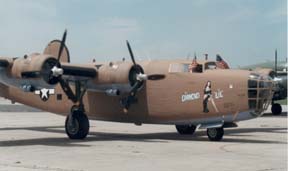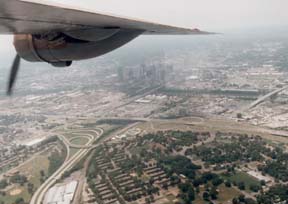

You are visiting http://geocities.datacellar.net/SoHo/Workshop/2096
To see an archive of the articles on this site, click here.

The Confederate Air Force's B-24 Liberator
Published Aug. 3, 1997
By Tim Wood
For some, World War II may be merely pages in a history book. But recently, some veterans of that major conflict brought the memory back to life.
The Confederate Air Force recently brought a couple of vintage World War II airplanes to the Nashville International Airport. I received a FAX message inviting me to take a ride in one of them, and you won't believe how fast
I dialed the phone to respond. It turned out that I was the first media representative to respond, so I got my pick of the aircraft to ride.
I had hoped to ride in the B-29 Superfortress, but a shortage of pilots kept the B-29 in Memphis. However, the CAF offered a ride in a World War II B-24 bomber instead, and there's no reason to complain about that kind of invitation.
Airplanes have fascinated me since childhood. I built plastic and wooden models of airplanes and read book upon book about aviation. I tried flying control line model airplanes, but couldn't handle anything bigger than the smallest planes.
In my early 20s, I earned a private pilot's license, but stopped flying several years ago because of the expense of renting aircraft.
Some of my happiest times have been at the controls of an airplane. 
One of those moments was when an Air Force Reserve unit took me up in the back seat of a F-4 fighter jet.
The pilot allowed me to handle the controls, albeit very briefly. I experienced dive bombing and learned what it felt like to "pull 4 Gs" - experience four times the force of gravity.
On two other occasions, I rode aboard an Air Force KC-135 tanker and witnessed aerial refueling of a B-52 bomber - once at night.
The B-24 ride was another incredible experience. The B-24 was the workhorse of the Air Force in World War II. Although a comparable aircraft, the B-17 Flying Fortress, received more glory in motion pictures, the B-24 carried its share of the load.
More B-24 bombers were built than any other World War II bomber. It was used in many roles, including reconnaissance and transport.
Many of the B-24 aircraft were built at the Willow Run plant in Michigan.
Another significant B-24 producer was the Consolidated plant in Fort Worth, Texas, which I visited on several occasions when I lived in Texas.
Today's military aircraft are jet-powered aircraft with incredible capabilities.
Compared to those sleek machines, the B-24 looks a bit clunky.
But beauty is in the eye of the beholder. For those young pilots who hauled bombs over enemy targets, any aircraft that would get you home was beautiful.
The aircraft was not designed with creature comforts in mind. The CAF's B-24 never flew a bombing mission. Shortly after it was built, the plane was damaged in a landing and subsequently converted to a transport.
CAF members will tell you about many interesting people who may have flown on the aircraft, but they ask that you do not publish the names, as they have not verified the stories.
The aircraft was not air conditioned. The ride was bumpy and the seats were uncomfortable. I didn't mind a bit.
There's something reassuring about hearing those four piston engines turn the propellers. Big propeller-driven aircraft produce an easily-recognizable humming sound that's almost musical.
If you're relying on those engines to keep you in the air, it definitely is music to your ears.
One wonders what it was like to be a 20-year-old pilot flying over enemy territory, knowing that at any moment enemy fighters might attack or ground-based guns might fill the air with flack.
The young men who flew those aircraft in combat grew up quickly. And we shouldn't forget the young women who flew the aircraft from the plants to their destinations.
Also, the men and women who designed and built the aircraft share the credit for its success.
The veterans of World War II are getting older and their number will dwindle.
The story of how a nation mobilized to win a world war is fading into the history books.
But the Confederate Air Force and aircraft such as the B-24 are keeping that memory alive.
The sound of a B-24 is the sound of freedom. I'm glad I experienced it first hand.
Published July 8 , 1997 in the Columbia Daily Herald
By Tim Wood
Jimmie Stewart was at the controls as the B-24 bomber circled the city. The mighty four-engined bomber flew in formation with another military plane seemingly surveying the city for a bomb run.
At any moment, you expected a German Messerschmitt to drop out of the sky and open fire just as you started the bomb run.
It wouldn't happen this day, because the date was July 7, 1997, and the city was Nashville, Tenn. Instead of bombs, the aircraft was carrying members of the news media. And in 1997, World War II is a memory.
But it's that memory that the Confederate Air Force is working to keep alive. The non-profit organization will have several World War II aircraft on display at Stevens Aviation at the Nashville International Airport this week.
The planes will be open to the public from 10 a.m. to 6 p.m. daily through Sunday, July 13. Admission is $5 for adults. Children under 12 are admitted free. There is an additional charge to go inside the airplanes.
All proceeds will go toward maintenance of the CAF's fleet of World War II aircraft. The expense is considerable - it cost the CAF $5,000 to fly in a B-29, B-24 and the C-46 for the exhibition, said Jimmie D. Stewart, a CAF member and pilot of the B-24.
Stewart was named for the actor and World War II pilot Jimmy Stewart, who died last week. The actor Stewart flew B-24 bombers during World War II. CAF pilot Stewart's father was a B-24 flight engineer during the war and admired the actor, so he named his son after him.
The CAF's Stewart has worked as an air traffic controller for 27 years and has operated several aviation-related businesses. He's flown for the CAF for 12 years and also pilots the B-29 and B-17 bombers.
The CAF's B-24 is one of only two flying B-24s in existence. Built in 1940, it was one of the first of 18,000 B-24s built for service in World War II.
But the CAF's aircraft, actually designated an LB-30, never saw combat. It was scheduled to go to England, but sustained extensive damage in a gear-up landing. It was converted to a transport and served as an executive transport for Consolidated Aircraft, manufacturer of the B-24.
Two other companies operated it as a transport before the CAF acquired it 12 years ago. Last year, volunteers renovated the aircraft at the Lockheed-Martin plant in Fort Worth, where several thousand B-24s were built.
Four Pratt and Whitney engines power the aircraft, each cranking out 1,200 horsepower and gulping 50 gallons of fuel an hour to drive its 12-foot propeller. Each engine carries 68 gallons of oil.
The aircraft is 67 feet long with a wingspan of 110 feet. Its rudder is 17 feet high, while the fuselage tops out at 12 feet. It requires a crew of three to fly it.
The B-24, nicknamed the "Liberator," was overshadowed somewhat by its more highly-publicized counterpart, the B-17 "Flying Fortress." But the B-24 had better range and was versatile enough to use in several missions, including the historic low-level raids on the oil fields of Ploesti.
Also appearing at the airport will be "Fifi," the last flying B-29 Superfortress. This aircraft is an example of the largest World War II bomber, which was used against Japan in the Pacific Theater of World War II. Variations of the plane served in the Air Force for many years after.
B-29 Superfortresses dropped atomic bombs on Hiroshima and Nagasaki, driving Japan to surrender to the Allies.
The CAF has announced that the B-29 will be grounded after this year due to high maintenance costs, meaning opportunities to see the aircraft will be limited to trips to the CAF headquarters in Midland, Texas.
Except for a few paid mechanics, all CAF members are volunteers and pay their own expenses. Stewart said it takes literally hundreds of people to keep the CAF's fleet of war birds in the air.
CAF member Keith Kibbe says the CAF's mission of "To keep the public mindful of what happened."
And on a sunny Monday more than 50 years after the end of World War II, the B-24 carried out that mission.
| Search this site! |
Home page||Send me an e-mail ||Click here for great deals on CDs!
||Tim Wood's Rocketry page ||Tim Wood's Music Page, featuring Chicago (the band)